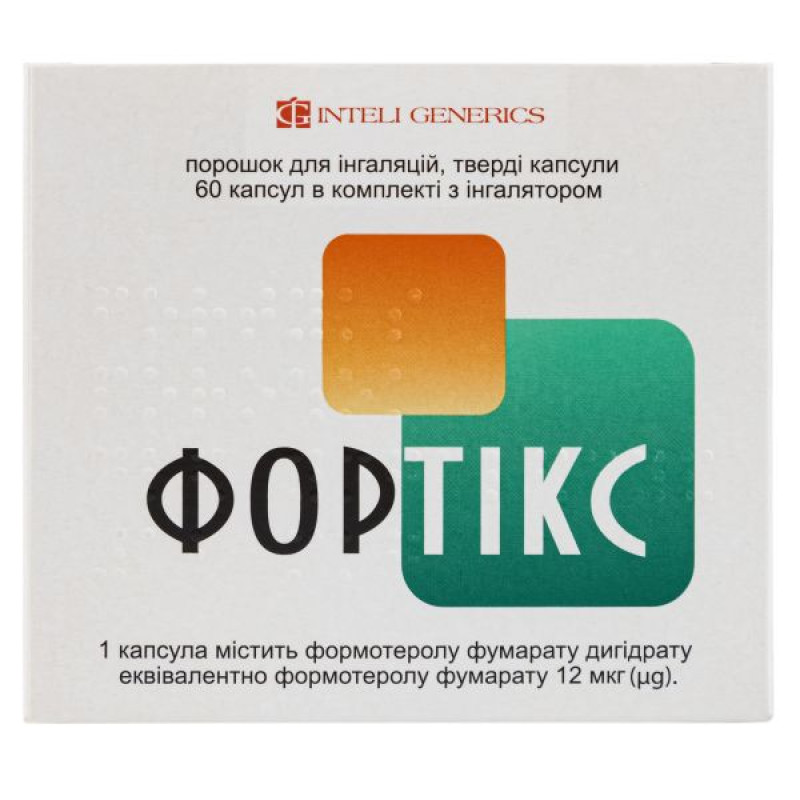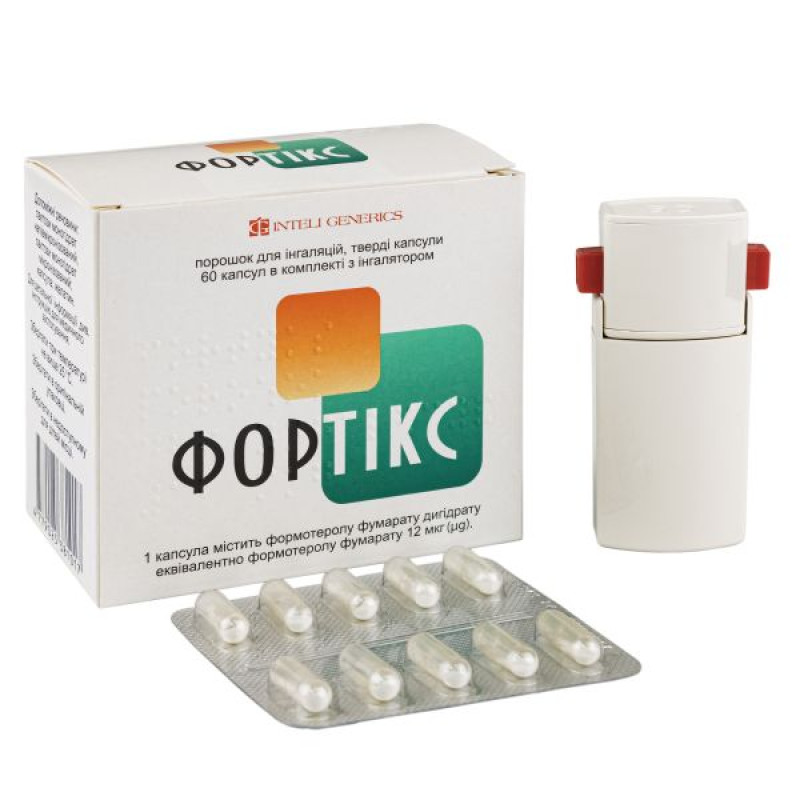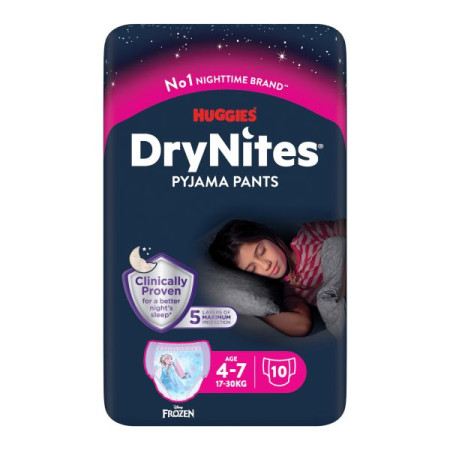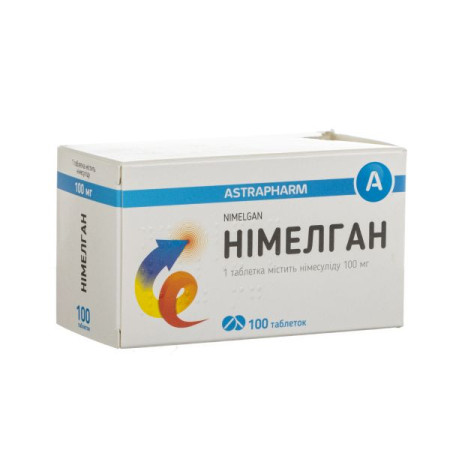Fortiks powder for inhalation, hard capsules 12 mcg, blister pack with inhaler No. 60
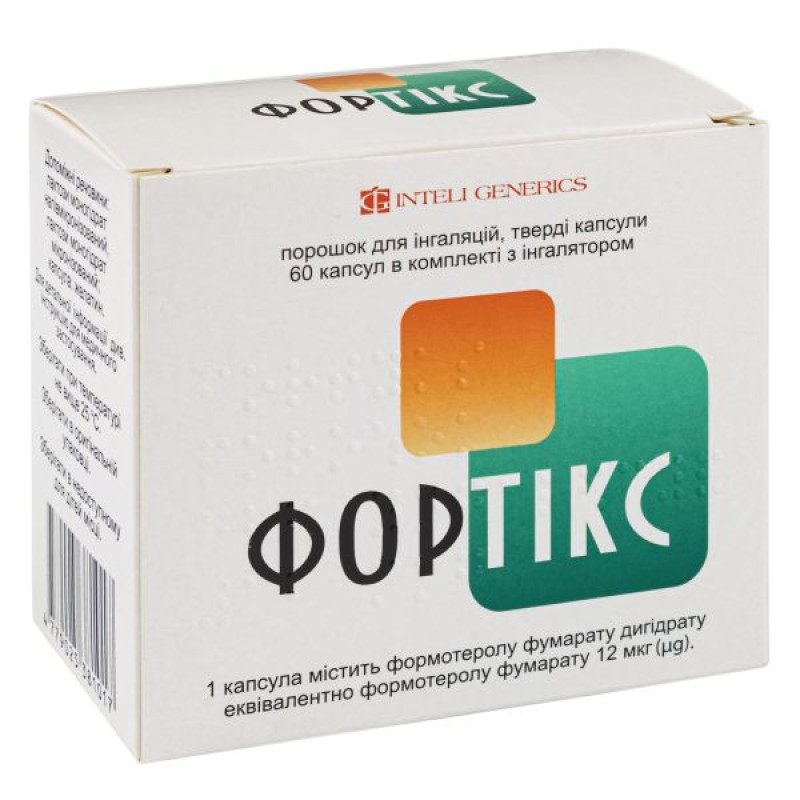
Pharmacological properties
Pharmacodynamics. Formoterol fumarate is a selective β2-adrenoceptor agonist. In patients with reversible airway obstruction, it has a rapid bronchodilating effect (within 1-3 min), which persists for 12 h after inhalation at a high level. In therapeutic doses, the effect on the cardiovascular system is minimal and occurs only in isolated cases.
Formoterol inhibits the release of histamine and leukotrienes from the passively sensitized human lung. Some anti-inflammatory effects have been observed, such as a reduction in the severity of edema and inflammatory cell accumulation.
Pharmacokinetics: As with other inhaled drugs, approximately 90% of formoterol administered by inhaler is swallowed and absorbed from the gastrointestinal tract. Therefore, the pharmacokinetic characteristics of oral formoterol are largely applicable to the inhalation powder.
Oral doses of formoterol fumarate up to 300 mcg are rapidly absorbed from the gastrointestinal tract. Cmax of the unchanged substance in plasma is reached after 0.5-1 hour. The extent of absorption of 80 mcg of the drug taken orally is ≥65%.
The pharmacokinetics of formoterol are linear within the tested doses of 20-300 μg orally. Repeated oral administration of a daily dose of 40-160 μg does not lead to significant accumulation of the drug in the body. After inhalation administration in therapeutic doses, formoterol cannot be determined in blood plasma using currently available analytical methods. However, the rate of excretion in the urine indicates rapid absorption after inhalation. The maximum rate of excretion after administration in a dose of 12-96 μg was in most cases reached after 1-2 hours.
Cumulative urinary excretion of formoterol after inhalation of the powder (12-24 mcg) and two aerosol preparations (12-96 mcg) demonstrates that the amount of formoterol in the blood plasma increases in proportion to the dose taken.
Binding to blood plasma proteins is 61-64% (of which 34% is with albumin), therefore, at concentrations achieved when administered in therapeutic doses, saturation of binding sites does not occur.
Formoterol is eliminated by metabolism, mainly by direct glucuronidation of the molecule. Another route of elimination is O-demethylation followed by glucuronidation.
Formoterol may be eliminated in several stages, the actual T½ depending on the dosing interval. Based on plasma concentrations 6, 8 or 12 hours after oral administration, a T½ of 2-3 hours was determined. The T½ estimated from the urinary excretion rate 3-16 hours after inhalation was approximately 5 hours.
The active substance and metabolites are completely excreted from the body; about 2/3 of the administered dose was found in the urine and 1/3 in the feces. After inhalation, an average of about 6-9% of the dose was excreted unchanged in the urine.
Renal clearance of formoterol is 150 ml/min.
Indication
Prevention and treatment of bronchoconstriction in patients with reversible bronchoobstruction, including chronic bronchitis, with or without emphysema.
Prevention of bronchospasm caused by inhalation of allergens, cold air or physical exertion.
Application
Fortix is intended for adults, including elderly patients, and children over 6 years of age.
Since the bronchodilator effect of formoterol is largely maintained after 12 hours, in most cases, maintenance therapy with the use of two inhalations per day makes it possible to control bronchoconstriction associated with chronic conditions both day and night.
supportive therapy
Adults and children over 6 years of age: 1 inhalation capsule (12 mcg) 2 times a day. In severe cases, 2 capsules 2 times a day may be prescribed. If necessary, 1 or 2 capsules per day can be used in addition to the maintenance dose to relieve symptoms. However, if the drug is used in high doses more often than usual (i.e. more than 2 times a week), the dose should be reviewed, as this may indicate a worsening of the underlying disease.
Prevention of bronchospasm caused by physical exertion or exposure to known allergens, which cannot be avoided
Adults: 1 inhalation capsule (12 mcg) approximately 15 minutes before exercise or allergen exposure. Patients with severe asthma may require 2 inhalation capsules (24 mcg).
Children aged 6 years: 1 inhalation capsule (12 mcg) approximately 15 minutes before physical activity or contact with an allergen.
application
A doctor or other healthcare professional should explain to the patient how to use the inhaler.
Capsules are removed from the blister only immediately before use.
1. Remove the protective cap.
2. To open the inhaler, grasp its base and turn the mouthpiece counterclockwise.
3. Place the capsule into the chamber at the base of the inhaler. It is important to remove the capsule from the blister pack only immediately before use.
4. Return the mouthpiece to the closed position.
5. Press the red buttons while holding the inhaler vertically. Release the buttons.
6. Exhale completely.
8. Hold your breath for as long as you can without discomfort, while removing the inhaler from your mouth. Then breathe out. Open the inhaler to check if there is any powder left in the capsule. If there is any, repeat steps 6-8.
9. After use, remove the empty capsule, close the mouthpiece and close the inhaler with the lid again.
To remove powder residue, clean the mouthpiece and capsule chamber with a dry cloth; you can also use a soft brush for cleaning.
Contraindication
Hypersensitivity to formoterol, other components of the drug or other β2-adrenergic agonists.
Tachyarrhythmia, 3rd degree atrioventricular block, idiopathic subvalvular aortic stenosis, hypertrophic obstructive cardiomyopathy, thyrotoxicosis.
Patients with suspected or established QT prolongation (QT c 0.44 s).
Children's age up to 6 years.
Side effects
Musculoskeletal system: tremor, muscle spasms, muscle pain.
From the cardiovascular system: increased heartbeat, tachycardia.
From the nervous system: headache, agitation, dizziness, restlessness, nervousness, insomnia, feeling of anxiety.
Respiratory system: worsening of clinical condition, dry mouth.
Other: irritation of the mucous membrane of the mouth and throat.
Isolated cases: hypersensitivity reactions such as severe hypotension, rash, angioedema, itching, peripheral edema, altered taste, nausea, irritation of the eye mucosa, eyelid edema.
Special instructions
The drug should not be used in patients with hereditary galactose intolerance, the Lapp lactase deficiency or glucose-galactose malabsorption.
Long-acting β2-adrenergic agonists are not intended (and are insufficient) for the basic therapy of asthma. Along with regular treatment with β2-adrenergic agonists, patients with bronchial asthma should be regularly treated with concomitant inhaled anti-inflammatory drugs (for example, corticosteroids and/or sodium cromoglicate in children) or oral corticosteroids. Before prescribing formoterol, the patient's condition should be assessed to determine whether the anti-inflammatory treatment he is receiving is sufficient. When control of asthma symptoms is achieved, the dose of formoterol should be gradually reduced. During the period of dose reduction, the patient's condition should be regularly monitored. The lowest effective dose of formoterol should be used.
Although formoterol may be included in the treatment regimen if inhaled corticosteroids do not provide adequate control of asthma symptoms, formoterol should not be initiated during a severe asthma exacerbation or in the event of a significant or acute worsening of asthma.
At the beginning of treatment with formoterol, there is a risk of developing side effects associated with asthma, as well as worsening of its course. If asthma symptoms remain uncontrolled or if the patient becomes worse after inhalation of formoterol, it is necessary to consult a doctor about the advisability of continuing treatment.
Anti-inflammatory treatment should not be discontinued after starting formoterol therapy, even if symptoms improve. Persistence of symptoms or the need for an increase in the dose of formoterol to control them usually indicates worsening of the underlying disease and the need for adjustment of treatment.
Fatalities have been reported with excessive use of β2-adrenergic agonists, although the exact cause of death is unknown. In several cases, the cause of death was cardiac arrest. Patients should be advised of the importance of strictly adhering to dosage recommendations and not exceeding the maximum dose.
When using β2-adrenoceptor agonists in doses higher than recommended, prolongation of the QT interval on the ECG was noted, which increased the risk of ventricular rhythm changes.
Dosage limits should be carefully evaluated for patients using formoterol in the following cases:
- ischemic heart disease;
- myocardial infarction;
- severe hypertension;
- cardiac arrhythmia;
- severe heart failure.
Treatment with β2-adrenergic agonists may cause potentially severe hypokalemia. Particular caution is required in severe asthma, as this effect may be potentiated by concomitant therapy and hypoxia. In such cases, it is necessary to monitor the level of potassium in the blood plasma.
As with other inhaled medications, the possibility of paradoxical bronchospasm should be considered; in such cases, the drug should be discontinued and alternative treatment should be instituted.
Given the hyperglycemic effects of β2-adrenoceptor agonists, it is necessary to monitor blood glucose levels in patients with diabetes.
Children: Formoterol is not used in children under 6 years of age.
Pregnancy and breast-feeding. The safety of formoterol during pregnancy and breast-feeding has not been established. The drug should not be used during pregnancy unless there is no other safe alternative. Like other β2-adrenergic agonists, formoterol may delay labor due to its relaxing effect on uterine smooth muscle.
Ability to influence the reaction speed when driving or operating other mechanisms. The patient should be warned about the possibility of deterioration in the ability to drive a car and complex mechanisms due to the development of side effects such as tremor or agitation.
Interactions
The use of drugs such as quinidine, disopyramide, procainamide, phenothiazines, antihistamines, and tricyclic antidepressants may be associated with prolongation of the QT interval and an increased risk of ventricular arrhythmia.
Additional use of sympathomimetic agents may increase the severity of cardiovascular reactions.
Formoterol should be used with caution in patients taking MAO inhibitors or tricyclic antidepressants, as they may enhance the effects of β2-adrenergic agonists on the cardiovascular system.
Concomitant treatment with xanthine derivatives, steroids or diuretics may enhance the possible hypokalemic effect of β2-agonists. Hypokalemia may increase the susceptibility to cardiac arrhythmias in patients taking digitalis. β-blockers β-blockers may weaken or nullify the effect of formoterol, therefore β-adrenergic blockers (including eye drops) should not be used concomitantly with formoterol unless there is no alternative.
Overdose
Symptoms: nausea, vomiting, headache, tremor, dizziness, palpitations, tachycardia, ventricular arrhythmia, metabolic acidosis, hypokalemia, hyperglycemia.
In case of overdose with formoterol, treatment should be discontinued immediately and supportive and symptomatic therapy should be initiated. In case of severe overdose, the patient should be hospitalized.
Storage conditions
In the original packaging at a temperature not exceeding 25 °C.
There are no reviews for this product.
There are no reviews for this product, be the first to leave your review.
No questions about this product, be the first and ask your question.







